
Mimicking physiological conditions helps researchers find metal binders
Researchers have developed a method for identifying small molecules that bind metal ions. Metal ions are essential in biology. But identifying which molecules—and especially which small molecules—those metal ions interact with can be challenging.
To separate metabolites for analysis, conventional metabolomics methods use organic solvents and low pHs, which can cause metal complexes to dissociate. Pieter C. Dorrestein of the University of California San Diego and coworkers wanted to keep the complexes together for analysis by mimicking the native conditions found in cells. But if they used physiological conditions during the separation of molecules, they would have had to reoptimize the separation conditions for each physiological condition they wanted to test.
Instead, the researchers developed a two-stage approach that introduces physiological conditions between a conventional chromatographic separation and a mass spectrometric analysis (Nat. Chem. 2021, DOI: 10.1038/s41557-021-00803-1). First, they separated a biological extract using conventional high-performance liquid chromatography. Then they adjusted the pH of the flow exiting the chromatographic column to mimic physiological conditions, added metal ions, and analyzed the mixture with mass spectrometry. They ran the analysis twice to obtain mass spectra of small molecules with and without metals. To identify which molecules bind metals, they used a computational method that uses peak shapes to infer connections between the spectra of bound and unbound versions.
One way to further mimic physiological conditions, Dorrestein says, would be to add high concentrations of ions such as sodium or potassium and low concentrations of the metal of interest. “It becomes a competition experiment. It will basically tell you, OK, this molecule under those conditions has more propensity to bind sodium and potassium or this one unique metal that you’ve added,” Dorrestein says. “We can infuse many different metals simultaneously, and we can really understand the preference and selectivity in that context.”
In culture extracts from Escherichia coli, the researchers identified known iron-binding compounds such as yersiniabactin and aerobactin. In the case of yersiniabactin, they discovered that it can also bind zinc.
The researchers identified metal-binding compounds in samples as complex as dissolved organic matter from the ocean. “That’s absolutely one of the most complex samples I’ve ever looked at,” Dorrestein says. “It’s probably as complex as, if not more complex than, crude oil.” The method identified domoic acid as a copper-binding molecule and suggested that it binds Cu2+ as a dimer.
“An omics approach to identify all metal-binding metabolites in a sample is extremely useful because of the importance of biological metal chelation,” Oliver Baars, who studies metal-binding metabolites produced by plants and microbes at North Carolina State University, writes in an email.
“Dorrestein and coworkers provide an elegant, much needed, assay to better probe what the physiological role of metal ions in the cell could be,” Albert J. R. Heck, a pioneer in native mass spectrometry analyses at Utrecht University, writes in an email. “A possible next step would be to extract the metabolites under native conditions from the cell and fractionate these also under native conditions, to see which metabolites do carry which endogenous cellular metal ions.”
Chemical & Engineering News
ISSN 0009-2347
Copyright © 2021 American Chemical Society
Post time: Dec-23-2021

